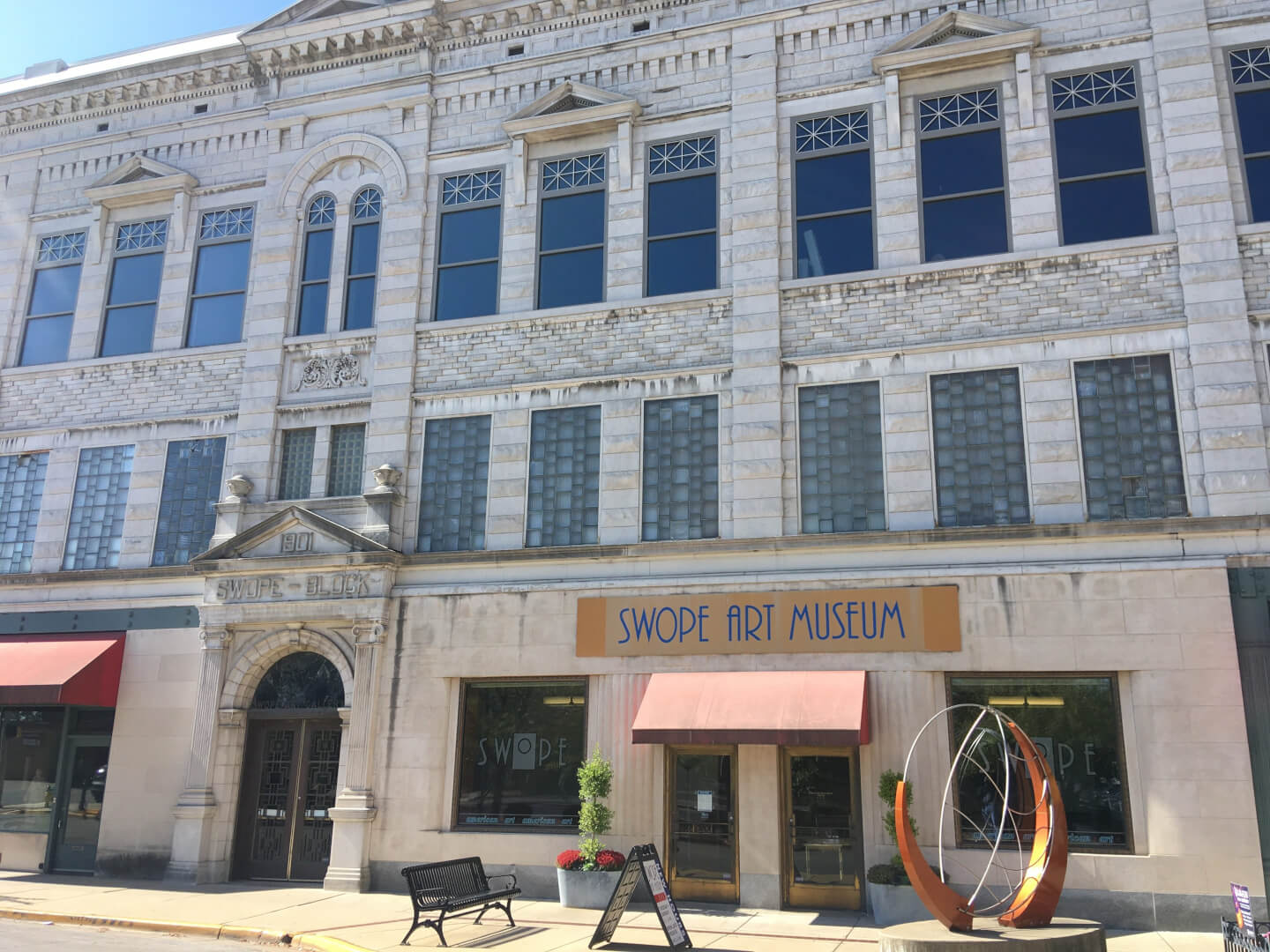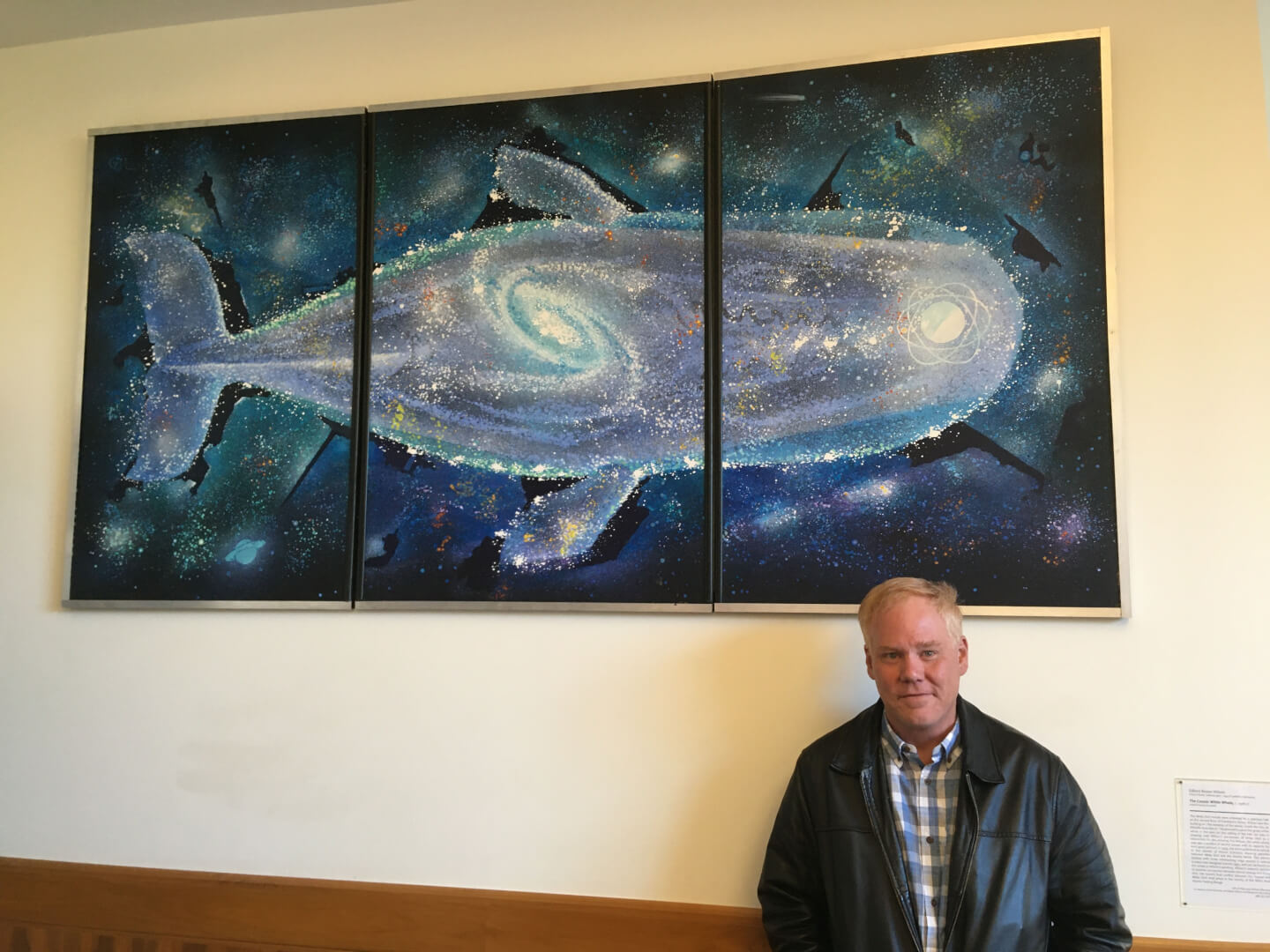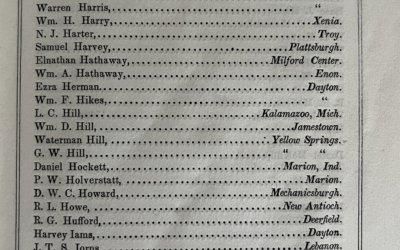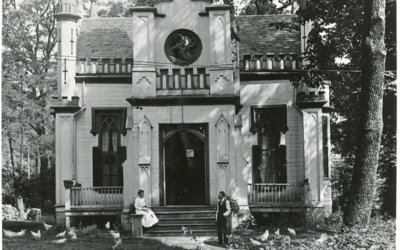
Unfinished Unbroken is the book I went all that way for. The cover features Wilson’s mural at Woodrow Wilson Junior High in Terre Haute.
Inspiration for this installment comes from recent adventures in Indiana and the release of a lost book published fifteen years after the death of its distinguished author. It all started on October 9th when Duffy got a Google alert late on a Friday afternoon that there was an Antioch-related book release happening at The Swope Art Museum in Terre Haute on the 11th. My plans for the weekend had suddenly changed, and Sunday morning I drove 200 miles to be present for the release of the long lost book about the local artist who created the very coolest thing Antioch College owns.

The Swope is a gorgeous old Beaux Arts commercial building in downtown Terre Haute converted into an Art Museum in the 1940s.
That’s not really where it all started. In January 2019, the Library received a call from Chicago writer/editor Robert Elder who said that, at long last, the biography of muralist Gilbert Brown Wilson by Edward K. Spann was finally coming out in print. What they needed was a current photograph of Wilson’s mural that has hung in the East Gym since the late 1930s. Wakka Ciccone, class of 2005, took the photo and Antiochiana provided additional historic images for publication as it has done for over a century.
That’s actually not where it all started, either, at least not for me. Ed Spann, emeritus professor of History at Indiana State University, first contacted the College in 2002 to inquire about the mural for a book he was writing about the artist. As far as I knew at the time, it was Wilson’s only extant work since his available writings alluded to his previous public art having been destroyed by those who hated it, most notably the mural he did for Woodrow Wilson Junior High School in his hometown of Terre Haute. Ed assured me the mural was not only still there but had undergone preservation. He visited campus soon after.

Atomic Whale by Gilbert Wilson expressing Moby Dick as an allegory for nuclear power along with some archivist. It hangs in the front lobby of the Swope.
While we examined Wilson’s Antioch mural, Spann asked if I wanted to co-author an article with him on the subject. I didn’t yet realize that the first of Ed’s seven books, Ideals and Politics: New York Intellectuals and American Liberalism, 1820-1880, had been nominated for a Pulitzer Prize in 1972, but it took very little guesswork to conclude that he was an experienced scholar with an impressive publishing record and I was not. I readily accepted, and the article we wrote together soon appeared in a 2003 issue of Timeline, the magazine of what was then called The Ohio Historical Society. That was a big moment for me (far bigger than it was for him) and one of the reasons I hold Ed Spann in such high regard.

The Debs Home on the campus of Indiana State University because I had to see where great trade unionist and five time Socialist candidate for president had lived. Sadly, the place was closed that day.
Our article did not include certain details of Wilson’s life (particularly those regarding his sexuality) Ed’s research had uncovered, which he was saving for a nearly finished full length biography. Ed never did finish it, though, dying at age 73 in 2004. Plans for a posthumous publication by the Indiana Historical Society in 2007 never came to fruition.
Enter into the story Rob Elder, who learned of Ed Spann’s “great lost book of the Midwest” during a visit to the Swope Art Museum in 2016. Almost instantly Rob became Gilbert’s champion, and three years later, he completed and released the book that many, including me, thought would never get released. Since no one there told me of the event, my presence was something of a surprise to all, which is perhaps one of the reasons I appeared in the next day’s issue of the Terre Haute Tribune-Star. I also bore gifts for the collections of Swope in the form of the many pages of 1930s Antioch publications devoted to the controversy the mural started (which was then kept going by Antiochians as only they can do), including Gilbert’s address to the community reprinted below.
From the Antioch Alumni Bulletin, May 1939
The Murals in the Gym
Gilbert Wilson Gives the Philosophy which Guides his Painting
I have been asked to express here something of my philosophy of art, and to make some remarks relative to the mural. It so happens that I am one who believes that no kind of art—no painting, no literature, no play, no work of a creative nature—in our day can have validity except as it relates vitally to the social scene. And so, upon the premise that all art must relate vitally to the social scene, I have approached the painting of the mural in the Gymnasium here at Antioch.
I believe that the intense instability of the social condition of the world prohibits me from painting as artists before my time have painted, both as to technique and to subject matter. I cannot see the virtue of painting murals in a lasting medium on what is, figuratively speaking, a crumbling wall. I believe that we who find ourselves impelled to create in this present day are committed by the very nature of the times in which we live to employ our talents, not toward the creation of beauty, but rather toward a preparation—I might even go so far as to say—a preservation of the chance for beauty.
There is an ancient proverb that runs like this: “Foolish is the man who boasts of his beautiful bracelets, having lost both of his arms in war.” It is simply that this is a day when the primary concern is arms, not the bracelets we wear on them. I am taking the bracelets, of course, as a symbol of all culture, all human refinement, all the accomplishment which the human race can lay claim to, above and beyond a purely physical or animal existence.
What is culture;—what is refinement;—what is human intelligence in the face of a thing like Fascism? Its tendency is not only to destroy these aspects of man’s life but literally to destroy life itself. Fascism is to the social state what insanity is to individual personality. Its only expression is violence. Its ultimate end is annihilation. To identify Fascism with destructiveness we have but to look at its inextricable relationship to the war approaching in Europe. Without seeming to be too much of a “calamity howler,” may I ask, if it is preposterous to assume that our civilization may possibly be on the verge of destroying itself? Never in all history, before 1914, did we have a World war. Another World war is following only two decades later. Doesn’t the very implication of the word “World,” as a descriptive term for these wars, have possibly some significance as to the ominous seriousness in which present civilization finds itself?
Returning to the analogy of the “bracelets,” we might even say that it is a more serious question than the mere preservation of a man’s arms. It is virtually a question of saving the whole man.
That the world problem becomes infinitely complex when considered in its manifold ramifications, I grant you. It seems horribly impossible of solution. But this vast and staggering complexity does not alter the fundamental simplicity of the world problem when looked at in terms of Man and Nature.
Mankind, the world over, since the primitive ages, has had a common enemy; nature. All in all, the forces of Nature are so savage, so inalterably relentless, so hostile and utterly regardless of Man that it seems sheer suicide for the human species to ignore the fact that that it is only through collective effort that they can ever expect to subdue and order the elemental principles involved in the struggle to live. The very instinctive impulse which impelled primitive man to band together instead of foraging as separate individuals must and will continue to effect a union of the world’s peoples. This ultimate union we might well believe to be a natural consequence were it not frustrated by the various forces growing out of the competitive idea of survival. Competition to survive in an age as potentially plentiful as ours is as senseless as grunting compared to speech.
It is widely claimed that there is in Man’s nature an inherent disposition to be bad, to be hateful, to be cruel and destructive. I do not believe it! And that is one of the premises upon which I base my philosophy as a painter. I believe all of Man’s anti-social traits derive from the age-old attitude of competitive survival, which is nothing more, I suppose, than the “economic determinism” of Karl Marx. Put the economic system right and Man will be right. I believe that.
And this leads me to believe that we must come to some form of society in which world’s wealth is owned and shared equally–by all people of the earth. To continue with the belief that it is possible to maintain an individualistic attitude toward the struggle to live is to deny the simple validity of “Together we stand, divided we fall.” The world’s armaments might be taken as the epitome of the physical abuse of the physical sciences. This towering of armaments is inevitable in an economic system based upon a nationalistic competition for world markets. Nations are but individuals exercising an individualistic attitude toward survival.
In the mural, where I have sought to paint the collapse of modern civilization under capitalism, it is but a picture of what one artist feels is ahead if something is not done.
What to do? The most as I see it is this: It is the artist’s task to try to sift the world problem down to the simplest, most cogent terms. Then it is his take to paint something which will seek to remind us of the few basic and fundamental premises upon which a solution of the world’s problems rests, namely these: First, absolute equality of the two sexes; second, that all races are equal—that they must and will slowly merge into one greater entity which will be the consummation of them all; and third, that mankind must so order his society that machines will do the labor, leaving him free to expand the spiritual propensities of his nature. The world problem cannot very well be reduced to simpler terms than these; and these simple terms are essentially what eh mural at Antioch shall attempt to set forth.
In essence then, the mural shall endeavor to set forth both a warning and an ideal. In the first panel, I am trying to paint the epitome of COLLAPSE. It will be an effort to express as complete a statement of chaos and destruction as is possible with pigments. A mural, you know, should be something which cannot be expressed in any other way except form and color. In this first panel I am trying as an artist to sound the last note in the scale of human values, the very deepest of doomful depictions, the utter essence of finality so far as a defeated civilization under a machine age can be conceived.
In contrast to this, without sentimentality, or dreamy fanciful imagination, I have tried to state as simply as possible the social idea—the ordered world state. Whereas the COLLAPSE panel is constructed with sharp angles and an absence of horizontal anfd vertical lines, the panel called ORDER will be built on the geometrical form known as the circle. Around a circular table are grouped the different races of the world eating. Beneath is a machinery comprised chiefly of wheels to express again the circle. The machinery is placed at the bottom of the ORDER panel because we might assume that is where order belongs in the ideal society. (In the COLLAPSE panel the machinery is at the top.) In the upper part of the ORDER panel is a circular symbol embodying Photosynthesis.
While Antioch College is famous for its work in photosynthesis, as carried on by the Kettering Foundation it is not simply for that reason that it has been incorporated into the mural. I have used the idea of photosynthesis primarily because it so significantly ties up with a depiction of THE ORDERED SOCIETY. The implications of photosynthesis are so vast in the beneficent possibilities to be released for the human race, once the secret of chlorophyll is resolved, that it might almost be said to presuppose the socialization of that virtually unlimited source of power. And that is how I have expressed it in the mural.
In the central panel, there shall be an effort to state simply the absolute equality of the two sexes—that neither is superior to the other. And in this same pictorial statement shall be an emphasis (in contradiction to the idiotic ideologies underlying Fascism) of the absolute equality of the races, their eventual and inevitable blending into one color; likewise the ultimate expansion of the spiritual propensities inherent in the generic human being. In essence, the central panel will proclaim the true emergence of Man—something expressing the human being that will be possible once mankind is freed from the tragic insecurity and suffering attending his present state.
It is upon this assumption—idealistic indeed—that some such state of human perfection can be realizable once man has ordered his society.
I believe it is the task of art to objectify and set forth these ideals.
An ordered society is undeniably one of the major goals of the human race. To the degree that it is achieved, we might suppose, to the extent that Man be allowed to take the next step in his long evolution up from the mud and slime out of which science tells us he began. When Man has ordered the economics of his physical existence, then—and then only—will he step forward and begin his spiritual evolution—a program as comparably vast, truly, as his physical evolution has been vast, And he will expand into an inconceivably wonderful state of being beyond any past or present estimation.
Would I be though mad if I say I see the people of the future communicating with each by means of what we now rather hoaxingly term mental telepathy? Mad if I see the eventual control of health and physiological functions so perfected and brought within the discipline of the mind that death will be unknown on the face of the earth? If I say I see men visiting the planets wresting them from unlivable temperatures and making them habitable? If I see these planets peopled and reached within the twinkling of an eye? Mad if I say I see ythe measureless measured? Infinity become finite? If I say I see the universe and eternity encompassed in the palm of a hand! Yes, I suppose it is madness. But in this madness, let me sing Walt Whitman’s Song of the Universe:
In this broad earth of ours;
Amid the measureless grossness and the slag,
Enclosed and safe in its central heart,
Nestles the seed perfection.By every life a share of more or less,
None born but is born,
Conceal’d or unconceal’d
The seed is waiting.
…Give me, O God, to sing that thought,
Give me, give him or her I love
This quenchless faith,
In thy ensemble, whatever else withheld
Withhold not from us,
Belief in plan of Thee enclosed in Time and Space,
Health, peace, salvation universal.Is it a dream?
Nay but the lack of it the dream,
And failing it life’s lore and wealth a dream,
And all the world a dream.
“Songs From the Stacks” is a regular selection from Antiochiana: the Antioch College archives by College Archivist Scott Sanders.



